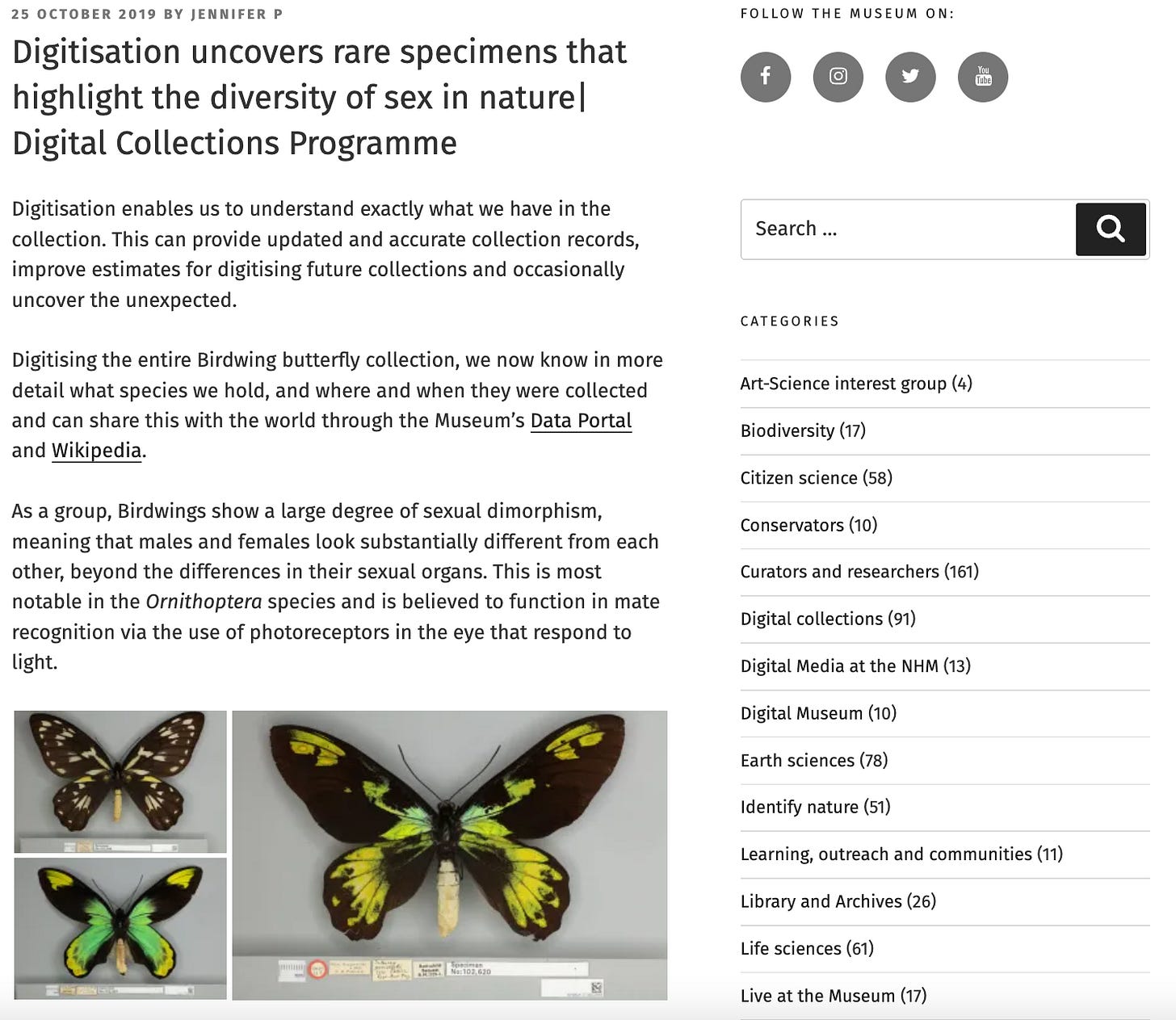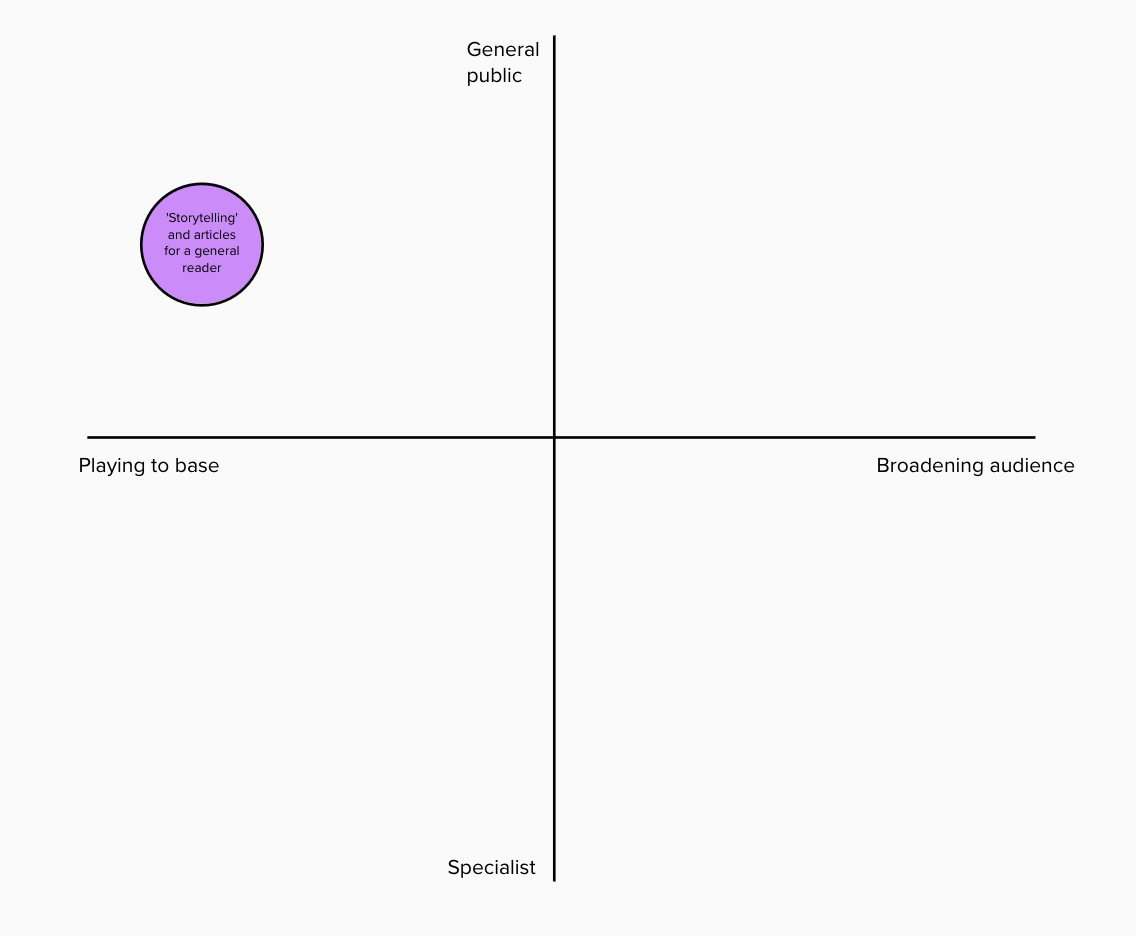Hi team Cultural Content,
Articles, editorial, blogs, ‘news and updates’: almost every cultural organisation has a section like this on their website.
And, over time, websites tend to accrue an unwieldy amount of this kind of content. Left unchecked, it’s easy for it to lose a coherent shape or purpose.
This article looks at what the point of creating all this content might be – who it’s for, and what purpose it can serve for your organisation in terms of digital audience development.
In 2016 the Royal Academy (RA) were reviewing the purpose of their online editorial content. Louise Cohen was Head of Content at the time (she’s now a fellow Content Strategist at One Further).
In her 2016 award-winning content strategy, she outlines how RA’s long form content was performing:
Essentially:
We’re amassing a lot of content
Only a minority of that content is doing well and being widely read
Content is playing to a core audience but not growing or diversifying that audience
To articulate the new RA content objectives, she framed all their content in terms of how it met their audience objectives of:
Grow
Deepen
Convert
Retain
In this post I’ll use this structure to look at different editorial formats and where they sit in terms of growing new audiences and engaging existing audiences.
1. Engaging existing audiences – specialist
Here’s an example from the Natural History Museum blog. It’s talking about a digitisation project and is probably mainly of interest to a specialist audience. But they’ve made sure the content is accessible to a non-specialist by:
Telling readers in the first paragraph what the post is about and what they’re going to learn
Starting the second paragraph explaining what the project has involved and why the reader should care
Using pictures to illustrate their points
Having short paragraphs
Explaining technical terms like ‘sexual dimorphism’ (in the third para)
Although it’s accessible to a general audience, this kind of content is most likely to be of interest to fellow entomologists and hobbyist groups who are already aware of the museum and subscribe to its feeds. That’s likely a deliberate choice on NHM’s part; to use their resources here to engage an important and highly engaged specialist group. Having worked in a natural history museum I’m well aware that they attract a lot of special interest groups, amateurs and hobbyists, and it’s important that museums are able to serve and advance the interests of this significant audience.
I’ve plotted where this sits on a spectrum of, on the one hand appealing to a specialist vs generalist audience, and – on the other hand – the extent to which this particular blog post plays to the museum’s existing base, as opposed to broadening their audience amongst more diverse communities:
In the next section, we’ll take a look at a few more editorial formats and where they sit on this same matrix.
2. Engaging existing audiences – generalist
This is a blog post from National Museums Scotland, written by their Curator of Modern and Contemporary History and entitled “Into the Hills: Digging for Scottish Gold”.
From the very start the piece tells an engaging story, whether you know anything about gold mining or not:
The opening paragraphs put you right in the heart of the action (“It’s February 2020 and I’m in a Landrover roaring up the side of Beinn Chiurn…”)
Striking images taken in real time from the journey she’s describing make the story visceral, personal and immediate
By visiting the source (“Scotland’s first commercial gold mine”) the curator situates what is essentially a new acquisition story in the context of the landscape where the raw materials came from
For all its charm and narrative style, this post is not going to bring in a new audience. Most museum blog posts are promoted to a general mailing list and on organic social media. This by default will only reach audiences who have already subscribed to view your updates.
Again, this is not a problem, so long as you’re clear what role this kind of content fulfils. It’s definitely still important to tell evocative stories to a general core audience on your mailing list and social media.
None of this is to disparage the work content creators produce, it’s rather an acknowledgement that digital content is often expected to be all things to all people – the silver bullet to growing and diversifying new audiences. And that’s unrealistic for content like this – unless you have a distribution mechanism and/or digital marketing budget that allows you to target your editorial content to audiences who haven’t already subscribed to see it.
3. Engaging new audiences – specialist
One way digital content can meaningfully move the needle in terms of engaging new audiences is through creating articles around core topics and keywords that are Search Engine Optimised.
Search Engine Optimisation (or SEO) is a complex beast these days and includes a number of factors that – as a content creator – you won’t directly be able to affect (such as how well structured your website code is). However where content editors can make a demonstrable dent in the effectiveness of their SEO is in ensuring articles use the kinds of keywords that someone might enter in Google to find your content.
Shakespedia is an online resource created by Shakespeare Birthplace Trust. It was specifically designed to put the organisation on the map in terms of online editorial content related to Shakespeare. Here’s an example:
In some ways, this isn’t as editorially clever as the lovely storytelling of ‘Digging for Scottish Gold’. But it’s not trying to be. It’s clever in so far as they’ve looked at the global searches queries around Shakespeare and systematically created content around topics that are a good fit with their organisation, have a relatively high search volume, and are relatively low competition. They’ve then created really rigorous, in-depth and expert content on these topics, which has delivered them a great deal of new search traffic, and new users (who’d never heard of Shakespeare Birthplace Trust before) to the website.
Although this is the first of the editorial examples we’ve looked at that has broadened audiences, it still relies on someone entering a specific term into Google. The new audiences who come across this content are likely to be Shakespeare educators, students and enthusiasts.
Seeing your editorial content as part of a broader ecosystem
Below I’ve created an overview where I’ve plotted different kinds of content cultural organisations produce on a matrix;
along the x-axis: to what extent content is broadening audiences, as opposed to playing to your base.
along the y-axis: the extent to which that audience is a specialist, versus a general public audience.
Purple circles are website content examples (i.e. the subject of this post).
Some summarising thoughts:
The majority of editorial web content produced by cultural organisations plays to their existing base, but can vary in terms of how specialist it is.
This is partly to do with how content is promoted. Email lists and organic social media, by default, will only reach people who have already heard of you.
There are of course exceptions to this, e.g. Adam’s ‘absolute unit’. This tweet (and others like it) were exceptionally good at reaching a millennial audience on Twitter. I’m not sure how realistic it is for most organisation’s digital audience growth plans to rely mainly on having an Adam/ absolute unit, particularly in a discipline (social media management) with a lot of turnover in it. On Facebook and Instagram you’re essentially working in spite of the algorithms if you manage to create organic viral content, since Meta’s business model and algorithm is predicated around you spending ad revenue to reach new audiences. If cultural organisations are serious about cultivating more diverse audiences using online content, organic social is unlikely to be the easiest – or most targeted – way to do it. This isn’t to decry the brilliance of creating viral content using organic social media, but rather an acknowledgement that not everyone can do this well , and that this approach won't necessarily achieve your audience development goals.
Some learning resource content and articles that are well optimised in search can (if done well) be excellent at bringing in new audiences who have a relevant interest in your content. If you’re new to SEO and would like some help, do get in touch for a chat.
It’s difficult for cultural organisations to use editorial web content alone to reach more diverse audiences. TikTok’s algorithm / For You Page at the moment is relatively sympathetic to this. Aside from that, digital initiatives that are embedded in community participation and filling a social need for a particular demographic (like – for example Opera North’s Couch to Chorus) are much more likely to affect systemic change amongst an audience you’re not currently reaching than even a very well written blog/tweet/article.
Above all, be clear up front with what you're trying to do – and include objective in every internal conversation you have about online editorial. Strategy is all about making decisions; if you try to do everything, you risk doing nothing at all.
That’s it for this week. I’d be really interested to hear how you’re using editorial and what audience objectives are working for you. I’ve included a free Mural template here which you can use to model your own board and drag and drop the content formats you’re creating against what objective it’s trying to achieve for your organisation. There’s also a blank / printable version below, which you could use to do a similar exercise with real Post-its (!!).
I’d love to hear your thoughts on matching content formats to what you’re trying to achieve in terms of digital audience development. If you’ve had ideas or comments as a result of this do get in touch: georgina@onefurther.com.











